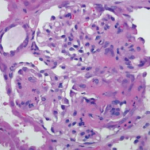Pulmonary artery involvement can be an isolated finding with GPA, without involvement of any other large vessels. Two case reports noted involvement of the ascending aorta, and one case reported involvement of the internal thoracic arteries and coronary arteries, along with the ascending aorta and pulmonary artery.5,9
Although one might argue that our patient could have an overlap of GPA and Takayasu’s arteritis, she is in her 60s, which is not the typical demographic, and she didn’t have involvement of the aortic arch, subclavian or carotid vessels on imaging.
Immunosuppressive therapy, including glucocorticoids and such agents as cyclophosphamide or rituximab, forms the cornerstone of treatment for ANCA-associated vasculitis with large-vessel involvement. However, its efficacy in addressing pulmonary artery stenosis remains variable. In the reviewed cases, immunosuppressive therapy improved the severity of stenosis in two of five medically managed cases, with one case remaining stable. Despite optimal medical management, two cases required pulmonary artery stenting due to progressive/persistent stenosis. This variability is likely explained by the underlying pathology: While immunosuppression effectively reduces active inflammation (arteritis), stenosis frequently results from irreversible fibrosis and vascular remodeling, which may not respond to anti-inflammatory or immunosuppressive agents.
ACR guidelines for Takayasu’s arteritis favor medical management over procedural management.11 However, in select cases, procedural interventions, such as pulmonary artery stenting, play a critical role in managing severe stenosis or refractory symptoms. Pulmonary artery stenting can provide immediate relief of vascular obstruction and improve hemodynamics when medical therapy alone is insufficient, as demonstrated in our patient. This approach is particularly relevant in cases of progressive or persistent stenosis despite optimal medical management. The use of pulmonary artery stenting in ANCA-associated vasculitis parallels its application in other large-vessel vasculitides, such as Takayasu’s arteritis, in which pulmonary stenting has been shown to improve oxygen saturation and alleviate dyspnea.12
When comparing open surgical and endovascular procedures in large-vessel vasculitides, open surgical approaches generally provide superior long-term patency. For example, a study in Takayasu’s arteritis reported a 79% success rate for open surgery, with a mean graft patency of 9.4 years, compared with a 52% success rate for endovascular procedures.13 Restenosis remains a significant issue with endovascular approaches, with rates reaching up to 50%. Studies have shown that this risk is closely linked to active inflammation.14
To improve outcomes, controlling inflammation before the procedure and using periprocedural steroids are crucial. The ACR recommends delaying surgical intervention in large-vessel vasculitis until the disease is quiescent to minimize risks of complications. Additionally, high-dose glucocorticoids are recommended in the periprocedural period if the disease is active.11

